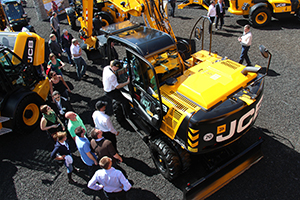
In a year of tough economic conditions worldwide, J.C. Bamford Excavators Ltd. outperformed the equipment sector in 2012 by posting earnings of $559.5 million—a record for the 67-year-old company—on $4.1 billion of sales and increasing production as others slipped.
"In view of the continued fragility of the global economy, which has led to renewed slowdowns in emerging and developed markets, JCB's results in 2012 are extremely encouraging," says JCB Chairman Sir Anthony Bamford.
The privately-owned, U.K.-based company, which announced the earnings on the first day of the April 15-21 Bauma exhibition in Munich, sold 69,250 machines in 2012, a slight increase over the previous year's 69,000, and grew margins even though the industry sold 845,000 units, or 10% fewer machines, than last year.
Company executives say they benefited from a 20% annual rebound in North American sales as well as increasing demand from Africa, Brazil, Russia and the Middle East. However, JCB and others saw business in China decline 37%, factoring largely into the industry-wide drop in unit sales.
This year, sales are poised to grow modestly as JCB begins to update its lineup to meet U.S. Tier-4 "final" clean-diesel standards that phase in through 2015. The new engines will reduce nitrogen-oxide emissions to near-zero levels.
JCB plans to use selective-catalytic reduction (SCR) for its line of Tier-4 final, four-cylinder EcoMax engines, which will use no diesel particulate filters or diesel oxidation catalysts. The company argues that this design is simpler than companies using all three aftertreatment devices.
Models fitted with JCB's "one-can" aftertreatment system are expected to produce fuel savings of up to 9% over the outgoing Tier-4 interim models. A Bauma, Cummins Inc. unveiled a 3.8-liter, four-cylinder engine design that also only uses SCR in the tailpipe.
Urea dosing also is more efficient than competitive machines, JCB says. Its SCR system injects urea into the exhaust stream at a rate of 2% to 3% per gallon of fuel. Most construction machines using SCR so far require a urea-fuel ratio of 6% to 7%, JCB says. The extra fluid costs can cut into the fuel savings that SCR systems typically provide.
The SCR technology will add an average 5% to 10% to the cost of a JCB machine, notes Tim Burnhope, JCB's chief innovation and growth officer. However, customers will see easier maintenance and fuel efficiency gains over the life of the equipment.
"If we can save them 5% to 10% per year, and they use the machine for three years, it will help offset the upfront cost," says Burnhope. Dealers in less-regulated markets can quickly "de-tier" the EcoMax engine by changing the engine's computer program, he adds.

